The Samsung Galaxy Tab S2 Review
by Brandon Chester on October 15, 2015 8:00 AM ESTSystem Performance
Tablets have always been devices where performance can be pushed further than a smartphone. There's much more thermal headroom and bigger batteries to drive high performance SoCs. Both Apple and NVIDIA have SoCs that cannot feasibly be put in a smartphone due to their heat and power usage, and these chips find their way into tablets where these factors can be managed and the additional performance can be utilized by more sophisticated applications. At the same time, some vendors opt to use the same silicon in both phones and tablets. In the case of the Galaxy Tab S2, Samsung has decided to use their Exynos 5433 SoC which previously shipped in the Galaxy Note 4 Exynos.
The CPU side of Exynos 5433 is a quad core Cortex A57 cluster with a max frequency of 1.9GHz, and a quad core Cortex A53 cluster with a max frequency of 1.3GHz. The GPU is ARM's Mali-T760 MP6 GPU with a max frequency of 700MHz. On average the results should be similar to the Galaxy Note 4 Exynos, although software improvements to both the browser as well as Android itself will obviously have an impact.
As always, the first group of tests are our web browser tests to characterize JavaScript performance, followed by BaseMark OS II and PCMark to evaluate the CPU and other aspects of a device's performance.
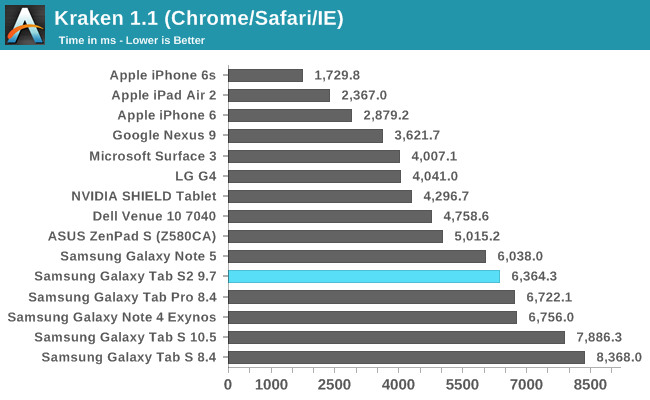
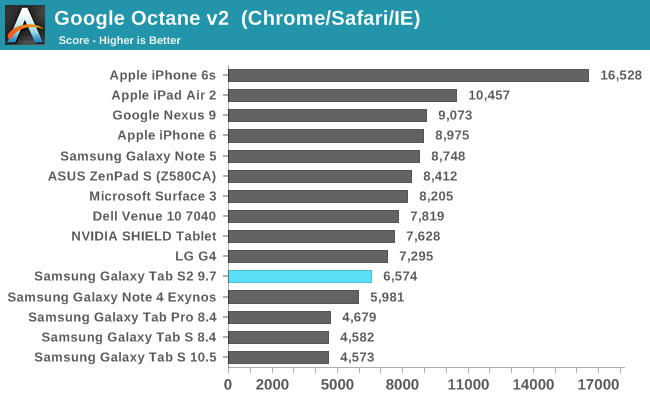
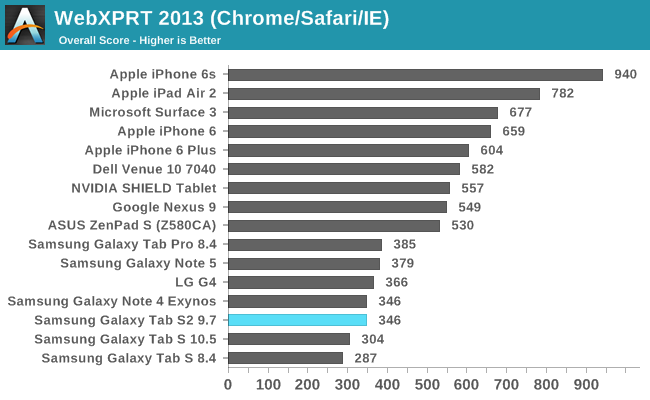
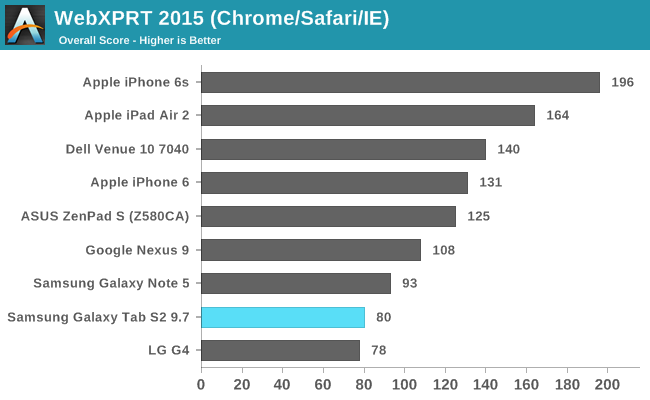
Android, and most specifically Chrome's lackluster JavaScript performance is something we've been commenting on for a while now. On top of that, the Galaxy Tab S2 simply doesn't have Samsung's latest and greatest SoC, and these factors combined together give results that aren't very impressive when one considers how much better the iPad Air 2 performs despite being over one year old at this point.
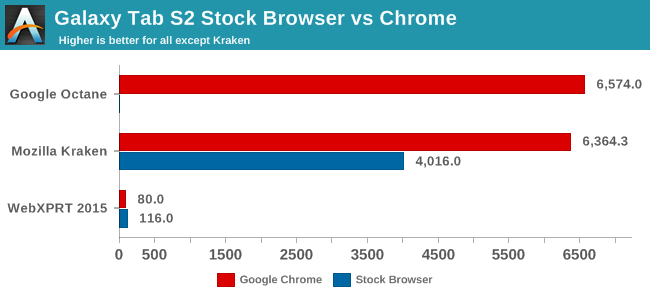
Looking at the Javascript performance in Samsung's stock browser provides some interesting but not unexpected data. It's clear that there's a much higher degree of optimization for Samsung's SoCs in their own browser than in Chrome, which isn't surprising. However, Samsung's browser isn't without its own issues. It actually crashes in the zlib test of Google Octane, and although the incomplete score of 7354 is higher than what Chrome achieves, the fact that the JavaScript code couldn't be properly executed points to some more concerning issues than performance
The other problem with using a device's stock browser for comparisons is that Android devices shipping with Google Mobile Services also include Chrome, and in my experience users are far more likely to utilize Chrome based on their awareness of the Chrome brand than they are to use the included OEM web browser. In short, while stock browser results may give a better idea of what kind of JavaScript performance a device is technically capable of, the Chrome results are more relevant when examining the performance and experience that the average user will have.
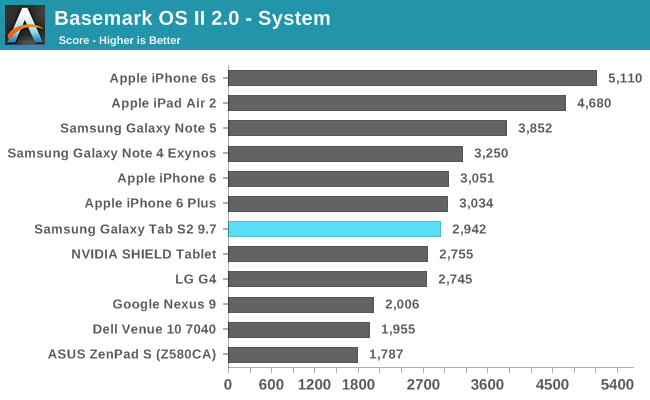
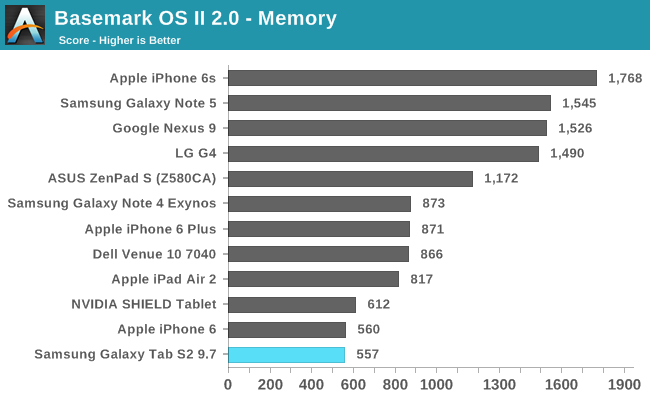

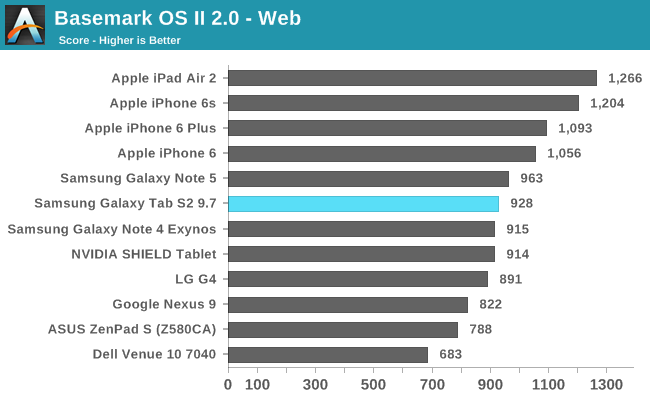
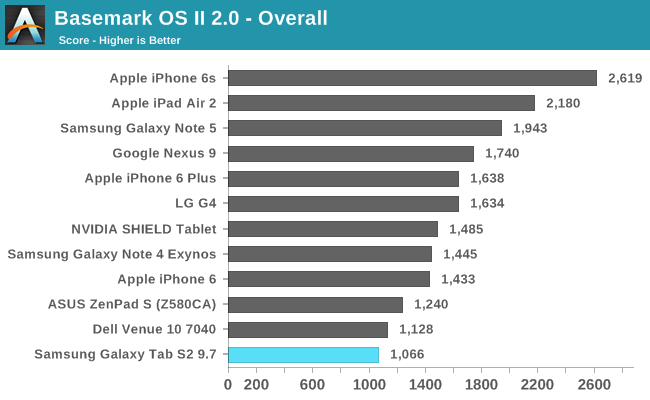
When examining the overall score in BaseMark OS II one may think that the Tab S2 performs extremely poorly. However, when looking at the sub tests it becomes clear that the overall score is being brought down by very low storage and graphics scores. What's surprising is the large gap between the graphics resuIts on the Tab S2 and the Galaxy Note 4 Exynos which uses the same Exynos 5433 SoC. I re-ran the benchmark several times to see if there was anything strange going on but there doesn't appear to be any problem with the testing, and I'm not quite sure why there's such a large gap between the two.
Moving past storage and graphics, the Tab S2 gets fairly good scores in the web and system tests. However, it still lags very far behind the iPad Air 2, and there's really no way to excuse this when both devices cost the exact same amount.
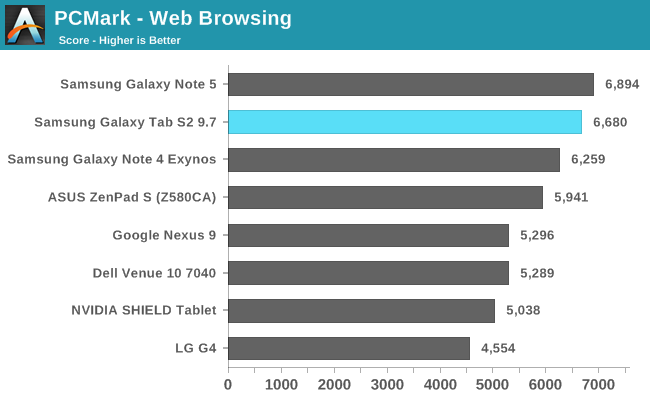



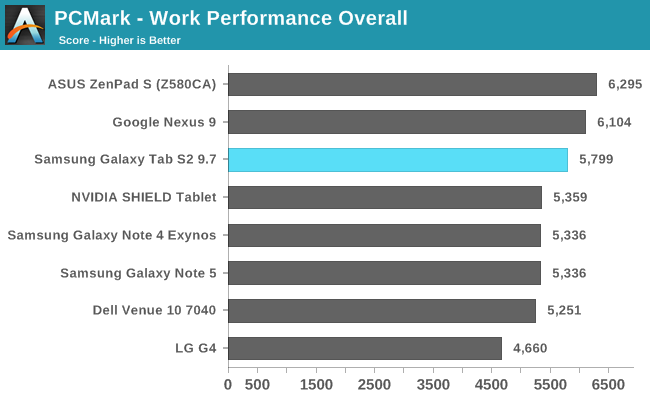
PCMark is still an Android only benchmark so the results here will strictly be comparing to other Android tablets. Overall, the Tab S2 does well. Upon examining the sub tests it can be seen that the Tab S2 is always fairly close the top of the charts, with certain devices achieving extraordinary scores in some tests which makes the Tab S2 look comparatively slower than it would be with more devices for comparison.
Exynos 5433 is not Samsung's best silicon, and even Exynos 7420 would likely struggle to compete with an SoC designed exclusively for full sized tablets. In the end the Tab S2's performance is just not competitive with the iPad Air 2 or even the Nexus 9 which is priced at $399 and often sells for even less. If I were looking at the 8" Tab S2 I would probably consider its performance acceptable relative to the competition at that size and price, but the market segment of full sized flagship tablets costing $500 or more is a completely other story.
I think Samsung definitely needs to reconsider their process of designing tablets, and part of that has to involve using chips that befit the larger size and greater capabilities of a tablet compared to a smartphone. It's in everyone's best interest to not have one company holding an enormous performance lead in any market, and if there's any company that has the capabilities, integration, and resources to fight with Apple over the tablet performance crown I would think it would be Samsung.










162 Comments
View All Comments
KoolAidMan1 - Saturday, October 17, 2015 - link
Samsung is just a foundry for Apple's designs. Just because they produce Apple's SoCs doesn't mean that they are entitled to using them in their own devices.psychobriggsy - Thursday, October 15, 2015 - link
Thanks for the review. A pretty poor showing from Samsung, for the price they want.All the review has done is show how worthwhile getting an iPad Air is.
cknobman - Thursday, October 15, 2015 - link
Agreed, not sure how this gets a good review.Horribly priced this needs to be <= $300.
FlyBri - Thursday, October 15, 2015 - link
@cknobman Totally agree. I'm really hoping Samung releases a higher end tablet soon with much better performance and battery life. The Tab S2 is fine, but comparing the specs and price to an Air 2, it has to much less than what Samsung wants.ummduh - Thursday, October 15, 2015 - link
I don't understand why Samsung continues to do this. They have the capability to make great hardware, and they do with their phones. But their tablets are just all around terrible. OK, well, they'd be great if they were sub $200. Seems like every tablet they've made has had some sort of huge fatal flaw, and some of them had multiple fatal flaws. I don't think I've ever seen Samsung make a compelling tablet.zodiacfml - Thursday, October 15, 2015 - link
It's all good, the performance and battery life but the price. An expensive picture frame and reader.Der2 - Thursday, October 15, 2015 - link
DAT nichijou episodes tho. I better see OPM on the next phone/tablet review haha. Good review as always Brandon.RGagne1975 - Thursday, October 15, 2015 - link
Looks like my Nexus 9 is still worth keeping. I guess I will have to wait for the review of the next Nexus tablet to see if I will want to upgrade or not.R. Hunt - Thursday, October 15, 2015 - link
I have to disagree with the reviewer about the quality of the screen. Text on the iPad Air 2 looks noticeably sharper than on the Tab S2 9.7, despite having the same ppi. I'm not sure if it's the screen itself or the rendering done by the OS has any influence on it, but I wasn't happy about it at all.The review also claims the original Tab S 10.5 had a pixel density of 320 ppi. Pretty sure that's not right and it was below 290 ppi.
Brandon Chester - Thursday, October 15, 2015 - link
Android's font rendering is a completely different topic, but it's definitely not the display itself. If you use both platforms regularly you sort of become accommodated to the differences, not unlike how one eventually gets used to how Windows and OS X render fonts completely differently.As for the PPI, you're correct. I must have messed up my math pretty badly there.